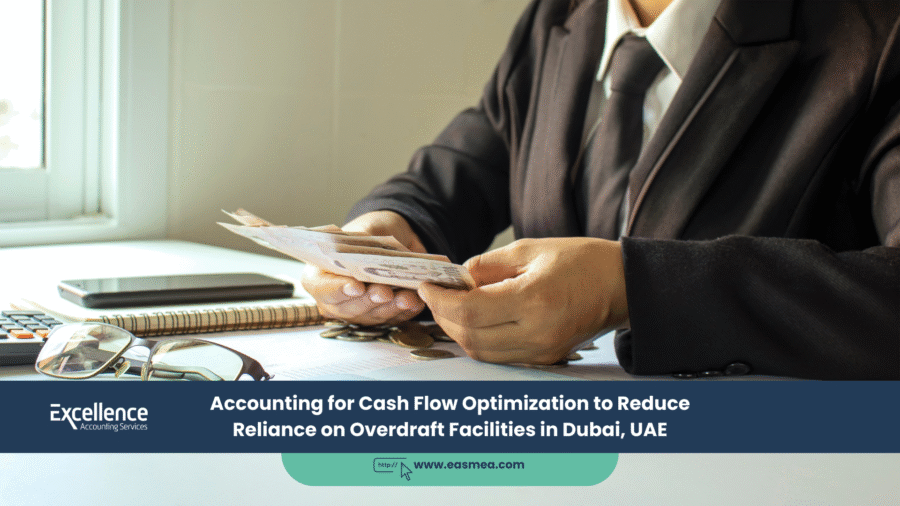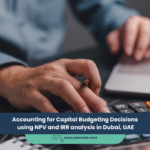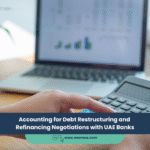Accounting for Cash Flow Optimization to Reduce Reliance on Overdraft Facilities
For many businesses, a bank overdraft facility feels like a necessary safety net—a convenient way to manage short-term cash shortfalls. However, consistent reliance on an overdraft is often a symptom of a deeper issue: poor cash flow management. Overdrafts come with high interest rates and fees, eroding profitability and masking underlying operational inefficiencies. The ultimate goal for any healthy business should be to treat the overdraft as a last-resort emergency fund, not a routine source of working capital.
- Accounting for Cash Flow Optimization to Reduce Reliance on Overdraft Facilities
- The Heart of the Matter: The Cash Conversion Cycle (CCC)
- Strategic Accounting for Cash Flow Improvement
- What Excellence Accounting Services (EAS) Can Offer
- Frequently Asked Questions (FAQs)
- Unlock the Cash Trapped in Your Business.
The key to achieving this lies in cash flow optimization. This is the strategic management of the cash moving in and out of your business to ensure you always have enough liquidity to meet your obligations. It’s an accounting discipline that transforms the finance function from a historical scorekeeper into a forward-looking, strategic driver of financial health. By mastering the levers of cash flow, a business can break the cycle of overdraft dependency and fund its operations from its own generated cash.
This guide provides a practical framework for business owners and finance managers on the accounting techniques used to optimize cash flow. We will dissect the cash conversion cycle and offer actionable strategies for managing receivables, payables, and inventory to build a robust and self-sustaining cash position.
Key Takeaways
- Profit is Not Cash: A profitable company on paper can still go bankrupt due to poor cash flow. Understanding this distinction is the first step.
- The Three Levers of Cash Flow: Optimization revolves around three core areas: accelerating Accounts Receivable, managing Accounts Payable, and minimizing Inventory.
- Shorten the Cash Conversion Cycle: The goal is to reduce the number of days it takes to convert your investments in inventory and other resources into cash from sales.
- Forecasting is Essential: A rolling cash flow forecast is your early warning system, allowing you to anticipate shortfalls and take proactive measures.
- Technology is an Enabler: Modern accounting software can automate many of the processes needed to improve cash flow, from invoicing to payment reminders.
The Heart of the Matter: The Cash Conversion Cycle (CCC)
The CCC is a critical metric that measures how long it takes for a company to convert its investments in inventory back into cash. A lower number is better. It is calculated as:
CCC = Days of Inventory Outstanding (DIO) + Days Sales Outstanding (DSO) – Days Payables Outstanding (DPO)
In simple terms, you want to:
- Sell your inventory quickly (reduce DIO).
- Collect cash from customers quickly (reduce DSO).
- Pay your suppliers as slowly as your terms responsibly allow (increase DPO).
Mastering this cycle is the core of cash flow optimization. A detailed financial health checkup can reveal weaknesses in your CCC.
Strategic Accounting for Cash Flow Improvement
Improving cash flow requires a disciplined approach across the business, led by the accounting function.
1. Accelerating Accounts Receivable (A/R)
This is about getting paid faster. Every day a customer invoice remains unpaid is effectively an interest-free loan you are giving them. Strategies include:
- Prompt and Accurate Invoicing: Send invoices the moment a job is complete or goods are delivered. Ensure they are clear, accurate, and contain all necessary payment information.
- Offer Early Payment Discounts: A small discount (e.g., 2% off if paid in 10 days) can incentivize customers to pay sooner.
- Implement Strict Credit Control: Have a clear policy for assessing new customers’ creditworthiness and a firm, consistent process for following up on overdue invoices.
- Make it Easy to Pay: Offer multiple payment options, including online payment gateways and direct bank transfers.
Dedicated accounts receivable services can professionalize this entire process.
2. Managing Accounts Payable (A/P)
While you want to get paid quickly, you should use the full credit terms offered by your suppliers. This is not about paying late; it’s about using the interest-free credit they have extended to you.
- Negotiate Better Terms: When possible, negotiate for longer payment terms (e.g., 60 or 90 days instead of 30) with your key suppliers.
- Schedule Payments Strategically: Use your cash flow forecast to schedule payments for their due date, not as soon as the invoice arrives. Avoid paying early unless there is a significant discount.
- Maintain Good Supplier Relationships: Good communication is key. If you foresee a problem paying a large bill on time, speak to your supplier in advance.
Effective accounts payable management is crucial for optimizing your DPO.
3. Optimizing Inventory
For many businesses, inventory is cash sitting on a shelf. Excess inventory ties up capital that could be used for operations or growth.
- Analyze Stock Turnover: Regularly identify and clear out slow-moving or obsolete stock, even at a discount, to convert it back to cash.
- Implement Just-in-Time (JIT) Principles: Where possible, order inventory closer to when it is needed for production or sale to reduce holding costs and the risk of obsolescence.
- Improve Forecasting: Use historical sales data to better predict demand and optimize your ordering cycles.
An overdraft facility treats the symptom of poor cash flow. Proactive accounting and financial management cures the disease.
What Excellence Accounting Services (EAS) Can Offer
Breaking free from overdraft dependency requires strategic financial management. Excellence Accounting Services provides the expertise to transform your cash flow and build a stronger financial foundation.
- Cash Flow Forecasting & Management: We build and maintain rolling cash flow forecasts that give you a clear view of your future liquidity, allowing you to anticipate and manage shortfalls proactively.
- Working Capital Optimization: Our CFO services provide a strategic review of your entire cash conversion cycle, identifying key areas for improvement in your A/R, A/P, and inventory management.
- Outsourced A/R and A/P Management: We can take over the day-to-day management of your receivables and payables, implementing professional processes to accelerate collections and optimize payments.
- Financial Reporting and Analysis: We provide clear, insightful financial reports that track the KPIs that matter for cash flow, so you always know the health of your business.
- Bank Negotiation Support: If you need to negotiate with your bank, we can help prepare the financial case and support you in discussions.
Frequently Asked Questions (FAQs)
No. An overdraft can be a useful tool for managing unexpected, short-term timing differences in cash flow. The problem arises when it becomes a permanent source of funding for the business, indicating a structural cash flow problem.
The cash flow statement is one of the three main financial statements (along with the P&L and Balance Sheet). It shows exactly how cash has moved in and out of the business from operating, investing, and financing activities. It provides the truest picture of a company’s liquidity.
Start with your opening bank balance. Add all expected cash inflows (customer payments, loans) and subtract all expected cash outflows (supplier payments, payroll, rent, taxes) for a given period (e.g., a week or month). This requires a detailed analysis of your sales pipeline, A/R aging, and A/P schedules.
This is a way to accelerate cash flow by selling your outstanding invoices to a third-party finance company. They give you a large percentage (e.g., 80-90%) of the invoice value upfront and the rest (minus their fee) when the customer pays them. It can provide immediate cash but is more expensive than traditional financing.
Absolutely. If a company with AED 1.2 million in annual sales on 30-day terms can reduce its average collection time (DSO) from 45 days to 35 days, it will permanently free up over AED 32,000 in cash.
Not necessarily. You need to calculate the effective annualized interest rate of the discount. A “2/10, n/30” discount is equivalent to a 36% annualized return. If your cost of capital (like an overdraft rate) is lower than this, you should take the discount. If not, it may be better to use the cash for the full 30 days.
Corporate tax is a significant cash outflow that must be planned for. You need to ensure you are setting aside cash throughout the year to meet your tax payment deadline, rather than facing a large, unexpected cash drain at the end of the period.
Overtrading occurs when a company grows its sales too quickly without having the working capital to support that growth. It leads to severe cash flow problems as the company struggles to pay for the inventory and expenses needed to fulfill the new orders before receiving payment from customers.
Seasonal businesses must be especially diligent with cash flow forecasting. You need to build up cash reserves during your peak season to cover your expenses during the slow season. An overdraft might be a planned tool to bridge the gap, but the goal should be to minimize its use.
Start by preparing a detailed 13-week rolling cash flow forecast. This short-term view will immediately highlight your weekly cash position, identify potential shortfalls, and force you to focus on the key drivers of your cash conversion cycle. It’s the most powerful, actionable tool in cash flow management.
Conclusion: Taking Control of Your Financial Destiny
Cash is the lifeblood of any business. Relying on an overdraft is like constantly needing a transfusion; it keeps you going, but it doesn’t solve the underlying problem. Proactive cash flow optimization, driven by disciplined accounting practices, allows a business to become its own source of strength.
By focusing on accelerating receivables, managing payables, and controlling inventory, you can take control of your financial destiny, reduce financing costs, and build a more resilient and profitable enterprise.
Unlock the Cash Trapped in Your Business.
Let Excellence Accounting Services analyze your cash conversion cycle and implement the strategies you need to optimize your cash flow.




